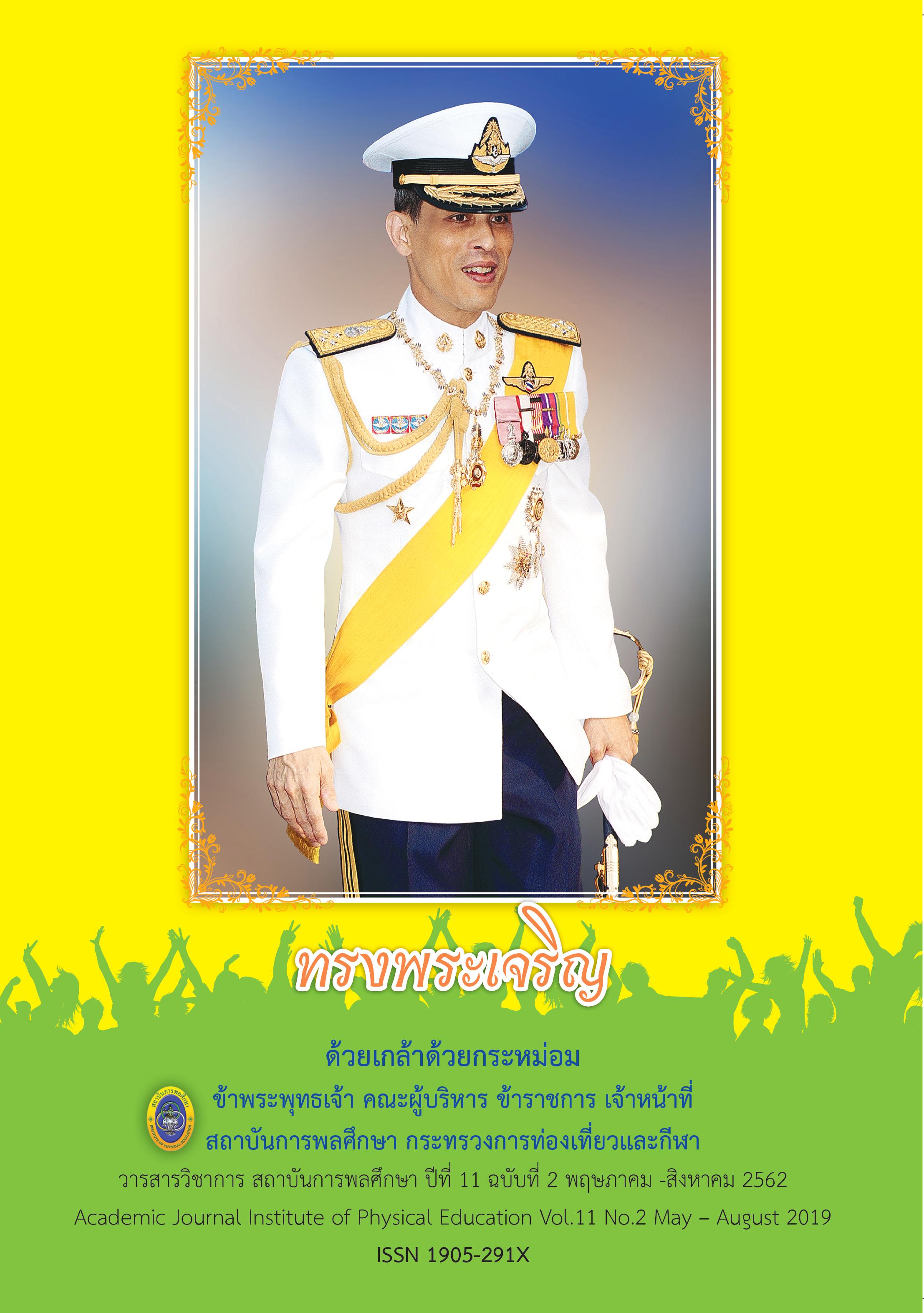DEVELOPMENT OF THE THAI EXERCISE ADDICTION INVENTORY
Main Article Content
Abstract
Nowadays, people are more interested in studying harmful effects of excessive exercise, also known as exercise addiction. In Thailand, not many studies have been conducted on this issue and no compulsive exercise test for Thai people has been found. The aim of the present study was to develop a Thai Exercise Addiction Inventory (TEAI) and to find out its validity and reliability. The TEAI was developed based on the original 6-item EAI of (Terry, Szaboo, & Griffiths, 2004). The Exercise Addiction Inventory was translated into Thai and back translated (Brislin, 1987) by experts in exercise and sports psychology, and English language specialists. The TEAI was pilot tested with 30 exercisers whose exercise behaviors were similar to the subjects. The reliability of the TEAI determined with Cronbach’s alpha was 0.75. The subjects selected through purposive sampling were 190 people (157 males and 33 females) in the age range 20-70 years living in Songkhla Province, Thailand who exercised by cycling, walking and running. The results of construct validate analysis and confirmatory factor analysis (CFA) showed that the model aligned with the empirical data (c2 = 12.24, df = 9, GFI = 0.97, AGFI = 0.95, CFI = 0.98, NNFI = 0.97, NFI = 0.95 and RMSEA = 0.04). It can be concluded that the Thai Exercise Addiction Inventory (TEAI) is a valid and reliable instrument for use in assessing exercise addiction of Thai people.
Article Details
The published article is a copyright of the Academic Journal of Thailand National Sports University. The passage appeared in each article in this academic journal is a perspective of each author which is not related to the journal. Each author is required to be responsible for all components of his/her own article. If there are any mistakes, each author must be responsible for those mistakes on his/her own.
References
คมกริช ฐานิสโร. (2554). ออกกำลังกายเป็นอันตรายต่อสุขภาพ?. Business Way Thailand, 5, 42-43.
จิราพร เขียวอยู่. (2543). โครงการอบรมระยะสั้นและการประชุมเชิงปฏิบัติการประจำปี 2543 หลักสูตรการสร้างมาตรวัดสำหรับงานวิจัยทางวิทยาศาสตร์สุขภาพ. ขอนแก่น: ภาควิชาชีวสถิติและ ประชากรศาสตร์ คณะสาธารณสุขศาสตร์มหาวิทยาลัยขอนแก่น.
สุชาติ ประสิทธิ์รัฐสินธุ์. (2540). ระเบียบวิธีวิจัยทางสังคมศาสตร์. กรุงเทพฯ: โรงพิมพ์เลี่ยงเชียง.
สุวิมล ติรกานันท์. (2550). การสร้างเครื่องมือวัดตัวแปรในการวิจัยทางสังคมศาสตร์: แนวทางสู่การปฏิบัติ. กรุงเทพฯ: โรงพิมพ์แห่งจุฬาลงกรณ์มหาวิทยาลัย.
Ackard, D. M., & Neumark-Sztainer, D. (2002). Date violence and date rape among adolescents: Associations with disordered eating behaviors and psychological health. Child Abuse & Neglect, 26(5), 455-473.
Brislin, R.W. (1986). The wording and translation of research instruments. In W. Lonner & J. Berry (Eds.), Field methods in cross-cultural research, 137-164.
Griffiths, M. (2002). The educational benefits of videogames. Education and Health, 20(3), 47-51.
Griffiths, M. D., Szabo, A., & Terry, A. (2005). The Exercise Addiction Inventory: A quick and easy screening tool for health practitioners. British Journal of Sports Medicine, 39 (e30), 1-2.
Griffiths, M. D., Urban, R., Demetrovics, Z., Lichtenstein, M. B., de la Vega, R., Kun, B., & Szabo, A. (2015). A cross-cultural re-evaluation of the Exercise Addiction Inventory (EAI) in five countries. Sports Medicine-Open, 1(1), 1-7.
Ferketich S. (1990). Focus on psychometrics. Internal consistency estimates of reliability. Research Nurse Health.; 13(6):437-440.
Hausenblas, H. A., & Downs, D. S. (2002). How much is too much? The development and validation of the exercise dependence scale. Psychology and Health, 17(4), 387-404.
Johnson, M. (2000). Understanding Exercise Addiction. The Rosen Publishing Group.
Lichtenstein, M. B., Christiansen, E., Bilenberg, N., & Støving, R. K. (2014). Validation of the exercise addiction inventory in a Danish sport context. Scandinavian Journal of Medicine & Science in Sports, 24(2), 447-453.
Li F, Harmer P, Chi L. & Vongjaturapat, N. Cross-culture validation of the task and ego orientation in sport questionnaire. Journal of Sport & Exercise Psychology; 1996; 18: 392-407.
Monok, K., Berczik, K., Urban, R., Szabo, A., Griffiths, M. D., Farkas, J., … & Demetrovics, Z. (2012). Psychometric properties and concurrent validity of two exercise addiction measures: A population wide study. Psychology of Sport and Exercise, 13(6), 739-746.
Ogden, J., Veale, D., & Summers, Z. (1997). The development and validation of the Exercise Dependence Questionnaire. Addiction Research & Theory, 5(4), 343-355.
Pasman, L., & Thompson, J. K. (1988). Body image and eating disturbance in obligatory runners, obligatory weightlifters, and sedentary individuals. International Journal of Eating Disorders, 7(6), 759-769.
Sicilia, Á., Alías-García, A., Ferriz, R., & Moreno-Murcia, J. A. (2013). Spanish adaptation and validation of the Exercise Addiction Inventory (EAI). Psicothema, 25(3), 377-383.
Szabo, A., & Griffiths, M. (2007). Exercise addiction in British sport sciences students. Intertiational Journal of Mental Health and Addiction, 5, 25-28.
Szabo, A., De La Vega, R., Ruiz-Barquín, R., & Rivera, O. (2013). Exercise addiction in Spanish athletes: Investigation of the roles of gender, social context and level of involvement. Journal of Behavioral Addictions, 2(4), 249-252.
Schumacker, R. E., & Lomax, R. G. (2010). A Beginner’s Guide to Structural Equation Modeling. (3rd ed.). New York: Taylor and Francis Group.
Terry, A., Szabo, A., & Griffiths, M. (2004). The exercise addiction inventory: A new brief screening tool. Addiction Research and Theory, 12(5), 489-499.
Warner, R., & Griffiths, M. D. (2006). A qualitative thematic analysis of exercise addiction: An exploratory study. International Journal of Mental Health and Addiction, 4(1), 13-26.
Youngman, J., & Simpson, D. (2014). Risk for Exercise Addiction: A Comparison of Triathletes Training for Sprint-, Olympic-, Half-Ironman-, and Ironman-Distance Triathlons. Journal of Clinical Sport Psychology, 8(1), 19-37.


